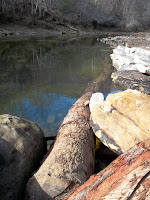I was reading the local newspaper yesterday about the bluegill, probably the most underrated fish that swims
in warm water. The bluegill is the fish I started out fishing
for when I was a little tot no more than four years old. My Mom would tell
my brother and me to watch the cork and then pull up on the cane pole to set
the hook and then retrieve the fish. We were landing some of the larger ones in a
creek channel that feed into our small pond below our house. We were excited
little boys, to say the least watching that cork go under and then playing the
fish to the bank. Another fun part of the trip was catching the green and brown grasshoppers we used as bait. This same scenario would play out on weekends when my Dad was
home and not working. As I get older I find myself reliving those days more
often. This spring my Grandson Bryson’s will go on his first fishing trip with
me and I plan to use the same tactics that my Dad and Mom used with me and my
brother when were little. He will be 4 years old and ready for the outing. Of course, it will
not be all fishing we will have to do a little exploring too. He loves the outdoors.
As most of you know I
have been challenging myself for the past two years to land 100 supersize
bluegills during the spawning season. Well, this year I am going to add a new
twist to the quest; I am starting my challenge early in March and ending it the
last of June. This early start will give me the chance to land some monster
bulls before they ever spawn. No one in the area fishes for these fish until
they go on the bed, so the early start will give me the edge. I will be using
nymphs in the form of wet flies and weighted nymphs. This means fishing much
deeper water as oppose to the spawning depths. The rod weights will also have
to be altered as well to compliment the nymphs. I like to use at least a 5
weight when I am going down under and a 4 weight when I am fishing the dries
and poppers. I intend to use more dries this year along with the tiny poppers,
especially in the clear waters of Smith. I feel the dries will help attract the
bigger gills off the rock walls early with all the insect activity happening there.
One of the best nymphs to use off the deep banks early is the famous bugger
The black bugger is deadly
How could I do this post on bluegills and not mention the Black Gnat, as I have said many times the best-wet fly I have ever used for gills-sorry the company that tied this pattern has gone out of business, I bought all he had left, which was close to 50 flies.
The Humpy will be one of my go-to dries throughout the spawn this year, this fly should be a killer is size 10 or 8
The Muddler Minnow is another excellent surface fly that will get results
The Bett's Popper in chartreuse, white and black all three are productive
This little popper is one of the best Betts poppers that I use. I especially like the black/white leg pattern.


















































